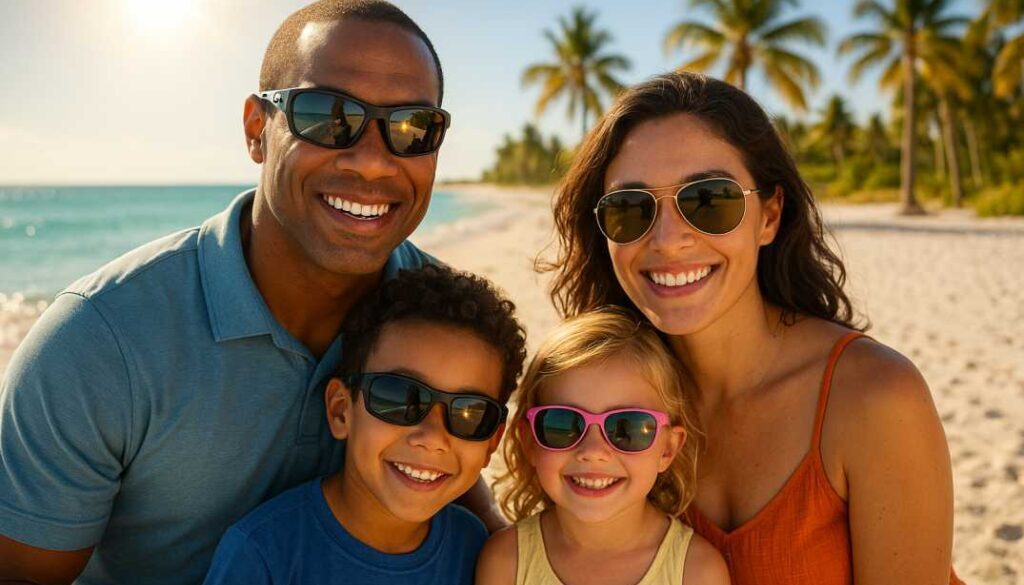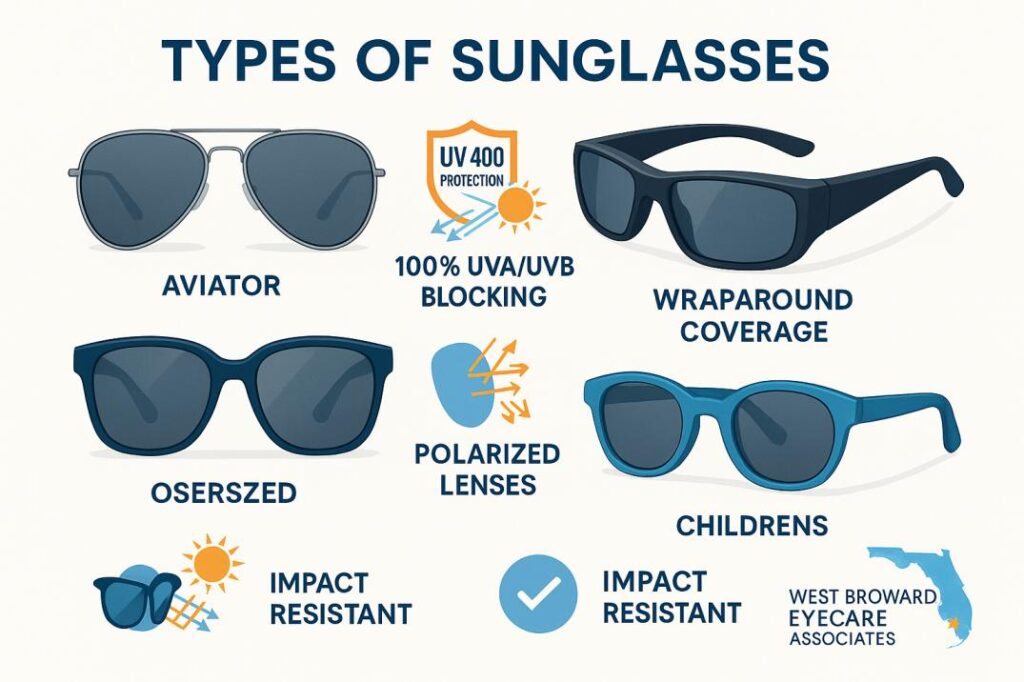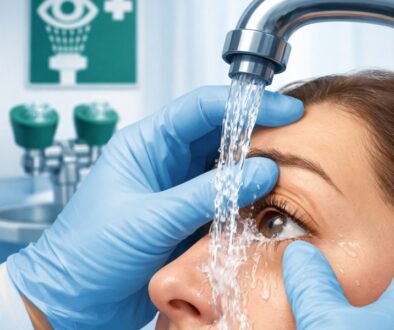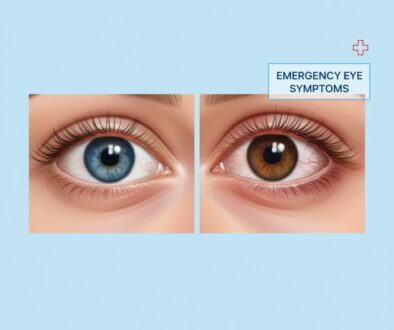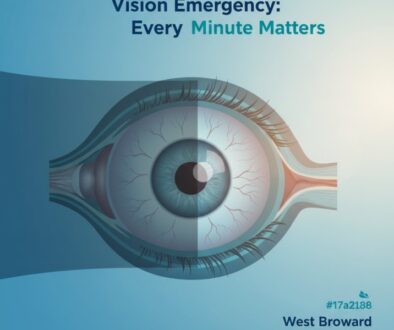Best UV Protection Sunglasses for Florida Sun
Florida’s year-round sunshine brings both joy and serious health risks to your vision. With UV radiation levels consistently ranking among the nation’s highest, Florida residents face unique challenges that demand more than ordinary sunglasses. As board-certified optometrists at West Broward Eyecare Associates, we witness daily the preventable eye damage caused by inadequate sun protection. This comprehensive guide provides evidence-based recommendations to help you make informed decisions about UV protection sunglasses that will safeguard your family’s vision for decades to come.
Understanding UV Radiation and Florida’s Unique Challenges
Why Florida’s Sun Poses Special Risks to Your Eyes
Florida’s intense sunlight isn’t just a concern during beach days. The Tampa Bay area regularly experiences UV Index levels ranging from 8-11+ during summer months, with some areas reaching extreme levels up to 12. According to current 2025 data, Tampa typically sees UV levels of 9-11 during peak hours (11 AM – 2 PM), placing it in the “Very High” to “Extreme” categories.
When ultraviolet radiation enters your eyes, it doesn’t just cause temporary discomfort—it creates cumulative damage that builds over decades. Recent 2024 research confirms that up to 20% of cataracts worldwide are linked to excess UV exposure, making proper eye protection essential for every Florida resident.
The Spectrum of Ultraviolet Radiation: What Florida Residents Face Daily
Understanding the enemy helps you choose the right defense. Ultraviolet radiation consists of three distinct types, each posing unique threats to your ocular health:
-
UVA Rays (315-400 nanometers): The most insidious form of UV radiation, UVA penetrates deeply into ocular tissues, reaching the macula and potentially triggering the cascade of cellular changes that lead to age-related macular degeneration. These rays comprise 95% of UV radiation reaching Earth’s surface.
-
UVB Rays (280-315 nanometers): Though less prevalent, UVB radiation packs significantly more energy than UVA. These rays primarily target your cornea and crystalline lens, accelerating protein degradation that manifests as cataracts. UVB intensity varies seasonally but remains dangerous year-round in Florida.
-
UVC Rays (100-280 nanometers): While Earth’s ozone layer filters most UVC radiation, artificial sources like welding equipment and germicidal lamps pose localized risks that Florida’s construction and healthcare workers encounter regularly.
Florida’s Compounding Risk Factors: Beyond Direct Sunlight
Three decades of clinical practice in South Florida have taught us that effective sun protection eyewear must address more than direct solar radiation. Florida residents confront a constellation of risk factors that create cumulative UV exposure far exceeding national averages:
-
Relentless Year-Round Exposure: Unlike temperate climates that provide seasonal UV relief, Florida maintains dangerous exposure levels throughout the winter months. Even December and January register UV Index levels of 4-6, sufficient to cause long-term ocular damage with repeated exposure.
-
Amplified Reflective Environment: Our state’s signature white sand beaches create an additional 15-18% UV load through reflection. Ocean surfaces contribute another 8-10%, while sea foam—ubiquitous along Florida’s coastline—can reflect up to 30% of incident radiation. This reflected radiation often bypasses traditional sunglasses, entering your eyes from below or from the sides.
-
Extreme UV Index Readings: Florida consistently ranks among the top three states for UV intensity. Our peninsula regularly experiences UV levels of 9-12+, with some coastal areas recording extreme readings exceeding 13 during peak summer conditions.
-
Lifestyle Amplification: Florida’s outdoor-centric culture means residents spend 40% more time in direct sunlight than the national average. Golf courses, beaches, boating, and year-round recreational activities create sustained exposure patterns that dramatically increase lifetime UV dose.
The Science Behind Effective UV Protection Sunglasses
What Makes Sunglasses Truly Protective
Not all sunglasses offer the same protection—a critical distinction that could determine your long-term eye health. It’s essential to understand that not all sunglasses offer the same level of protection. Key features to consider include: 100% UV Protection: Look for sunglasses labeled with “100% protection against UVA and UVB” or “UV400,” ensuring complete UV coverage.
Essential Protection Features
When selecting sun protection eyewear for Florida’s intense sun, prioritize these evidence-based features found in quality UV protection sunglasses:
100% UV Protection (UV400). This is non-negotiable. UV 400 protection lenses block wavelengths up to 400 nanometers. They also screen out 75% to 90% of visible light from the sun. Look for labels stating:
- “100% UV protection”
- “UV400”
- “100% protection against UVA and UVB”
Large Lens Coverage. Not only are oversized sunglasses in style, but they also offer the largest shield from sun damage. Wraparound-style sunglasses offer even more protection by preventing UV rays from entering along the sides. Studies show that up to 20% of UV exposure comes from light entering around the edges of standard frames.
Quality Lens Materials Professional-grade lens materials make a significant difference in long-term protection:
- Polycarbonate: Naturally UV-blocking, impact-resistant, and lightweight
- High-index plastic: Thinner profiles with embedded UV protection
- Glass: Excellent optical clarity with UV-blocking treatments
Clinical Evidence: The Research Behind UV Protection Recommendations
Our recommendations stem from rigorous peer-reviewed research that demonstrates the critical importance of comprehensive UV protection for Florida residents. Three landmark studies published between 2023-2024 provide the scientific foundation for our clinical protocols:
- Landmark Study 1: Protein Degradation Mechanisms (2024) Research published in Frontiers in Ophthalmology utilized advanced spectroscopic analysis to document UV-induced changes in human lens proteins. The study’s most significant finding confirms World Health Organization estimates: up to 20% of cataracts worldwide result from preventable UV exposure. For Florida residents, this translates to approximately 400,000 preventable cases of vision-threatening cataracts over the next decade.
- Landmark Study 2: Cumulative Exposure Modeling (2023) Photochemical sciences research employed precise dosimetry measurements to quantify real-world UV exposure patterns. The study concluded that chronic UV effects on corneal and lens tissues are cumulative and irreversible, making systematic protection essential throughout life. The research specifically noted that individuals in high-UV environments—such as Florida—face accelerated damage timelines.
- Landmark Study 3: Pediatric Vulnerability Analysis (2024) Perhaps most concerning for Florida families, recent pediatric ophthalmology research demonstrates that children’s eyes transmit significantly more UV radiation to internal structures compared to adult eyes. The study found that UV radiation can penetrate to the retina in children under 10, creating vulnerability windows that extend far beyond previously understood risk periods.
Eye Conditions Caused by Florida’s Intense Sun
Immediate UV-Related Eye Damage
Photokeratitis (Sunburned Eyes), sunburn of the cells on the front of the eye, and it’s painful. In many cases of photokeratitis (damage to the cornea) and photoconjunctivitis (damage to the thin layer of tissue covering the eye), these eye injuries usually heal on their own if you completely avoid the sun for a week. However, repeated episodes increase long-term damage risk.
Long-Term UV-Related Conditions
- Cataracts. While aging is the most common cause of cataract formation, it is far from the only one. Environmental conditions, such as Florida’s intense and frequent sunlight, can significantly accelerate the breakdown of proteins within the lens. UV protection can reduce cataract formation by approximately 5%.
- Macular Degeneration UV-A rays can hurt your central vision by damaging the macula, a part of the retina at the back of your eye. For Florida residents with a family history of AMD, UV protection becomes even more critical.
- Pterygium and Pinguecula. These growths on the eye’s surface, commonly called “surfer’s eye,” develop from chronic UV exposure. UVR incident from the periphery is refracted into the eye, and due to the focusing effect of the cornea, UV radiation is on average 22-fold stronger at the nasal limbus, which is the typical site for pterygium and pinguecula.
- Skin Cancer Around the Eyes. One study out of Australia estimated that about 90% of malignant tumors on the eyelid were basal cell carcinomas. The delicate skin around your eyes needs protection that only comprehensive sun protection eyewear can provide.
Choosing the Right Sunglasses for Florida Living
Professional Recommendations for Sun Protection Eyewear by Activity
Beach and Water Sports
- Polarized lenses: Essential for reducing glare from water and sand
- Wraparound design: Protects from reflected UV rays
- Floating straps: Practical for active water sports
- Saltwater-resistant frames: Important for long-term durability
Golf and Outdoor Sports
- Brown or amber tints: Enhance contrast for better depth perception
- Impact-resistant polycarbonate: Safety during active sports
- Secure fit: Stays in place during movement
- UV400 protection: Non-negotiable for extended outdoor exposure
Daily Driving and Commuting
- Gray tints: Maintain true color perception
- Polarization: Reduces road glare and dashboard reflections
- Comfortable fit: Essential for extended wear
- Gradient lenses: Optional for dashboard visibility
Prescription Needs For Florida residents requiring vision correction, prescription sun protection eyewear offers the best combination of clear vision and UV protection sunglasses functionality. We can incorporate your exact prescription into high-quality UV-blocking lenses, ensuring you never have to choose between clear vision and eye protection.
Lens Technology and Coatings for Florida Conditions
Advanced Lens Technologies
- Photochromic (Transition) Lenses: These lenses automatically adjust to changing light conditions, ideal for Florida’s variable cloudiness. However, photochromic lenses may be good UV-absorbent sunglasses (again, the label must specify this); it can take a few minutes for them to adjust to different light conditions.
- Polarization Benefits and Limitations Polarized lenses reduce the glare bouncing off reflective surfaces such as water or roads. Polarization itself does not provide UV protection. Instead, it provides a better experience for certain activities like driving, boating, or golfing. Always ensure polarized lenses include UV protection.
Specialized Coatings
- Anti-Reflective (AR) Coating. While beneficial for regular glasses, antireflective coatings can increase UV exposure by causing back reflection of the UV rays into the eye. For sunglasses, standard AR coating may not be ideal.
- Mirror Coatings: These provide additional light reduction and can offer some peripheral protection, making them excellent for extreme Florida sun conditions.
- Scratch-Resistant Coatings are Essential for Florida’s sandy, active environment, where lens scratches are common.
Frame Selection for Maximum Protection
Coverage Considerations
Sunglasses that wrap around the temples prevent the sun’s rays from entering from the sides. Some studies have shown that enough UV rays enter around standard sunglass frames to reduce the protective benefits of the lenses.
Frame Size and Style Recommendations
Large Frames: Provide maximum coverage for the eye area and surrounding skin.n Wraparound Styles: Block peripheral UV exposure. Close-Fitting Designs: Minimize gaps where UV rays can enter.r Comfortable Nose Bridges: Ensure consistent wear throughout the day
Material Considerations for Florida
Plastic Frames
- Lightweight and comfortable in the heat
- Less likely to become uncomfortably hot
- Wide variety of styles and colors
- Generally more affordable
Metal Frames
- Durable and long-lasting
- Precise fit adjustments are possible
- It can become hot in the direct Florida sun
- May cause discomfort during extended outdoor exposure
Special Considerations for Florida Families
Children’s Eye Protection
Children’s eyes are even more vulnerable to UV damage than adults. This is because the lens of a child’s eye cannot filter UV light as effectively as an adult’s eye. For Florida families, this means starting UV protection early is crucial.
Recommendations for Children:
- Start UV protection as early as 6 months old
- Choose impact-resistant polycarbonate lenses
- Ensure a comfortable, secure fit to encourage consistent wear
- Consider fun colors and designs to make wearing sunglasses appealing
- Replace frequently as children grow
Seniors and UV Protection
Florida’s large senior population faces unique challenges. Aging is the most common cause of cataracts, but UVB accelerates cataract formation. For seniors, comprehensive UV protection becomes even more critical as cumulative damage adds to age-related changes.
Common Myths About UV Protection Sunglasses and Sun Protection Eyewear
Uncertain about your current sunglasses’ protection level? Schedule a professional UV assessment to verify your eye protection meets Florida standards.
Myth 1: Darker Lenses Provide Better UV Protection. When looking for sunglasses, don’t be fooled into thinking the darker the lens, the more they’ll protect your eyes from the sun. Only sunglasses with 100% UV protection provide the safety you need.
Myth 2: Expensive UV Protection Sunglasses Are Always Better Quality. Sun protection eyewear doesn’t have to be expensive to be safe and effective. Drugstore sunglasses labeled as 100% UV-blocking are a better choice than designer sunglasses with no protection.
Myth 3: You Only Need UV Protection Sunglasses on Sunny Days.UV rays aren’t necessarily blocked by cloud cover, so your eyes could be at risk even on overcast days. Florida’s high ambient UV levels require year-round sun protection eyewear for optimal eye health.
Myth 4: Polarization Equals UV Protection in Sun Protection Eyewear Polarization is unrelated to UV protection, so you still need to ensure UV absorption of the lenses. Always verify both features separately when selecting quality UV protection sunglasses.
Professional Testing and Verification
How to Verify UV Protection
If you’re uncertain about your current sunglasses’ protection level, simply take them to an optical shop, where they can be tested in a photometer. Most opticians will test them for free, and it takes less than 30 seconds.
Quality Testing at Home
Look at something with a rectangular pattern, like a tiled floor. Hold the glasses at a comfortable distance from your face while covering one eye. Move the glasses slowly from side to side, then up and down, looking through the lenses. If the rectangular lines stay straight, the lenses are fine. If the lines are wavy or wiggly (especially in the center of the lens), discard them and search for a better pair.
When Sunglasses Aren’t Enough
Extreme UV Environments
Normal sunglasses will not protect your eyes from certain light sources. These include tanning beds, snowfields, and arc welding. You need special lens filters for these extreme situations.
Additional Protection Strategies
- Wide-brimmed hats: Provide additional facial and eye area protection
- Seeking shade: Especially during peak UV hours (10 AM – 4 PM)
- UV-blocking contact lenses: Complement sunglasses for comprehensive protection
- Regular eye exams: Monitor for early signs of UV-related damage
Caring for Your UV Protection Investment
Proper Maintenance
To ensure your sun protection eyewear continues providing optimal protection:
- Clean lenses regularly with appropriate cleaning solutions
- Store in protective cases to prevent scratches and damage
- Avoid extreme temperatures that could damage lens coatings
- Replace when damaged – scratched or damaged lenses may compromise protection
- Have professional adjustments to maintain proper fit
When to Replace Your Sunglasses
- Visible scratches on lenses
- Loose or broken frames affecting fit
- Outdated prescription (for prescription sunglasses)
- Any damage that might compromise UV protection
- Every 2-3 years for optimal protection assurance
Making the Right Choice for Your Florida Lifestyle
Questions about insurance coverage for prescription sun protection eyewear? Contact our insurance specialists for detailed information.
Budget Considerations for UV Protection Sunglasses
Quality UV protection doesn’t require breaking the bank, but investing in durable, well-fitting sunglasses ensures consistent protection. Based on 2025 market data:
Budget-Friendly Options ($15-50):
- Many drugstore brands offer UV400 protection for under $20
- Clip-on sunglasses with full UV protection are available for $15-25
- Basic polarized sunglasses with UV400 typically cost $30-50
Mid-Range Options ($50-150):
- Quality frames with advanced lens technology typically range $60-120
- Prescription sunglasses usually start around $80-100
- Sports-specific designs with enhanced durability cost $75-150
Premium Options ($150+):
- Designer brands with superior optics and warranty coverage
- Specialized prescription lenses with advanced coatings
- Professional-grade frames for extreme conditions
Consider:
- Insurance coverage: Many vision insurance plans cover prescription sunglasses
- Value over time: Quality frames last longer and provide better protection
- Family packages: Some providers offer discounts for multiple family members
- Seasonal promotions: Take advantage of sales while maintaining quality standards
Professional Consultation Benefits
Working with experienced eye care professionals ensures you receive:
- Accurate UV protection verification for your sun protection eyewear
- Proper fit assessment for maximum coverage and comfort
- Prescription integration is needed for UV protection sunglasses
- Personalized recommendations based on your Florida lifestyle
- Ongoing support and adjustments for optimal eye protection
Ready for a professional eye exam and UV protection consultation? Book your appointment with West Broward Eyecare Associates today.
Resources and Citations
This comprehensive guide draws from current scientific research and authoritative health organizations to provide accurate, evidence-based information about UV protection and eye health in Florida.
Key Scientific Studies Referenced
-
“UV light and the ocular lens: a review of exposure models and resulting biomolecular changes” – Frontiers in Ophthalmology, September 2024
This peer-reviewed study confirms WHO estimates that up to 20% of cataracts worldwide may be caused or enhanced by sun exposure, providing crucial evidence for the importance of UV protection in Florida’s intense sun environment.
https://www.frontiersin.org/journals/ophthalmology/articles/10.3389/fopht.2024.1414483/full -
“Recent Statistics on the Impact of UV Exposure on Eye Health” – Vision Center, March 2025
This comprehensive analysis provides current statistics on UV-related eye conditions, including updated data showing that at least 20% of cataracts worldwide are linked to excess UV exposure, with particular relevance to high-UV regions like Florida.
https://www.visioncenter.org/resources/uv-exposure-statistics/ -
“How to Choose the Best Sunglasses to Avoid Sun Damage” – American Academy of Ophthalmology, May 2024
The leading professional organization for eye care provides authoritative guidance on sunglasses selection, UV protection standards, and eye safety recommendations that inform our professional recommendations for Florida residents.
https://www.aao.org/eye-health/glasses-contacts/sunglasses-3
Disclaimer: This article is for educational purposes only and does not replace professional medical advice. Always consult with qualified eye care professionals for personalized recommendations regarding your vision health and UV protection needs.
Conclusion: Protecting Your Vision in the Sunshine State
Living in Florida offers incredible opportunities to enjoy outdoor activities year-round, but it also demands serious commitment to protecting your eyes from intense UV radiation. The cumulative nature of UV damage means every day without proper protection adds to your lifetime risk of vision-threatening conditions.
At West Broward Eyecare Associates, we understand that your vision represents an irreplaceable asset requiring proactive protection. As your community’s vision guardians, we combine three decades of clinical experience with cutting-edge diagnostic technology to help you select UV protection sunglasses and sun protection eyewear precisely calibrated for Florida’s challenging conditions.
Experience the difference that professional eye care makes. Contact West Broward Eyecare Associates today to schedule your comprehensive eye examination and UV protection consultation. Your vision deserves nothing less than the best.
Protect your family’s vision with professional expertise. Contact West Broward Eyecare Associates today to explore our comprehensive selection of UV protection sunglasses and sun protection eyewear, backed by personalized consultations from board-certified optometrists who understand Florida’s unique challenges.
FAQs
-
Florida requires 100% UV400 protection and wraparound styles to block intense sun and side glare that regular sunglasses often miss.

